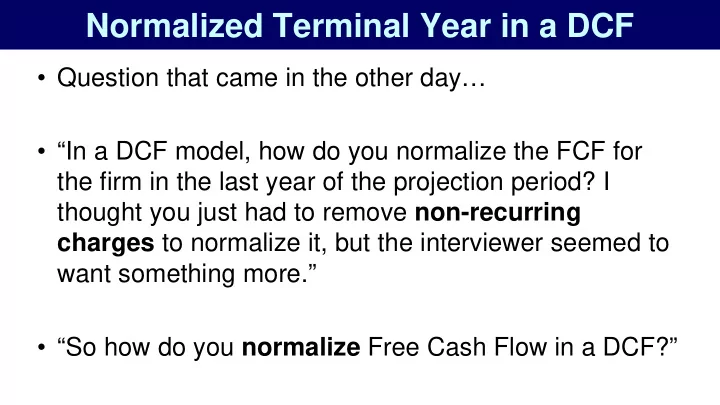

Normalized Terminal Year in a DCF • Question that came in the other day… • “In a DCF model, how do you normalize the FCF for the firm in the last year of the projection period? I thought you just had to remove non-recurring charges to normalize it, but the interviewer seemed to want something more.” • “So how do you normalize Free Cash Flow in a DCF?”
Normalized Terminal Year in a DCF • Terminal Value: Represents the PV of the company’s FCFs beyond the end of the last year into infinity… • Often based on the Final Year FCF and a Growth Rate : Final Year FCF * (1 + FCF Growth Rate) (Discount Rate – FCF Growth Rate) • Growth Rate: Often linked to GDP growth, inflation, etc.
Normalized Terminal Year in a DCF • PROBLEM: What if a company’s Free Cash Flows in the projection period are not consistent with what it looks like in a “steady state”?
Normalized Terminal Year in a DCF • Admittedly: Yes, that is an extreme example, but there are plenty of other issues that might come up for “normal” (i.e., non-biotech/pharma) companies: Issue #1: Does the revenue growth rate make sense? Issue #2: Are the margins reasonable? Issue #3: Do CapEx and D&A make sense? Issue #4: Are the WC req’s similar to historical #s? Issue #5: Is the tax rate free of the impact of NOLs, tax credits, and other items that expire?
How to Apply These Tips to Our DCF • Application #1: We’re assuming a lower revenue growth rate of ~5% because the company’s key product patent expires 1-2 years before will probably grow at a much lower rate going forward until it “strikes gold” again • Application #2: We’re adjusting the EBIT margin down to 45% key product (Xyrem) is far less profitable with lower prices (due to generics) in the Terminal Period
How to Apply These Tips to Our DCF • Application #3: Can’t assume that big Amortization of Intangibles expense and non-cash add-back will continue indefinitely. Why? 10-Q says the useful life is only 13.3 years, and our projection period is 10 years… …so this Amortization will end soon after the final year! And we’re not assuming the company spends anything to acquire or develop more intangibles
How to Apply These Tips to Our DCF • Application #4: We’re making CapEx as a % of revenue slightly lower to reflect lower re-investment in the business… but it still stays above D&A as a % of rev. • Application #5: We’re also making the Change in WC as a % of the Change in Revenue slightly lower patent expiring threw off the numbers there • Check: What does the Normalized Year FCF look like now? Is the growth rate more consistent?
How to Apply These Tips to Our DCF • Taxes: If a company has Net Operating Losses (NOLs), tax credits, etc., they should not apply forever. They’ll expire or be used up at some point! • Solution #1: Extend the projection period until these are used up, at which point the cash taxes increase • Solution #2: Just assume they don’t exist in the Normalized Year and start the higher cash tax rate then • Solution #3: Ignore them in FCF and only factor them into Ent. Value Eq. Value calculation at the end
What NOT to Do to Normalize FCF • CapEx = Depreciation: No, no, no… not justified: 1. Due to inflation alone, CapEx will increase each year… whereas Depreciation is based on older, less inflated CapEx figures 2. If a company’s FCF is growing in the Terminal Period, it almost always has to increase its asset base to support that growth 3. Plus, there could be productivity gains , declining technology costs over time, etc.
What NOT to Do to Normalize FCF • Assume HIGHER Growth or Margins: This approach very rarely makes sense – what company grows at a faster rate 10 years into the future? • Margins: Can sometimes be justified if the company plans to cut costs somehow… but even this is questionable • Tax Benefits: Should not continue indefinitely – only justification for a lower tax rate is if the company’s tax jurisdiction is different from its home country
Normalized Terminal Year in a DCF • Recap and Summary: Normalize the Terminal Year FCF in a DCF when the company’s FCFs in the Projection Period are not consistent with its FCFs in the Terminal Period • Extreme Example: Bio/pharma company with a key patent that expires in the final year far lower FCF after • Issues to Check: Revenue growth, margins, CapEx and D&A, Working Capital, and tax rate/NOLs/credits
Normalized Terminal Year in a DCF • Here: We adjusted the revenue growth and margins down, slightly tweaked some of the others, and removed Amortization of Intangibles in the Terminal Year • Impact: Got a ~3% FCF growth rate in the Terminal Year instead of an unjustifiably high 15-20% growth rate • What NOT to Do: Don’t make CapEx = D&A, don’t assume higher growth or margins, and don’t assume an unsustainably low tax rate
Recommend
More recommend